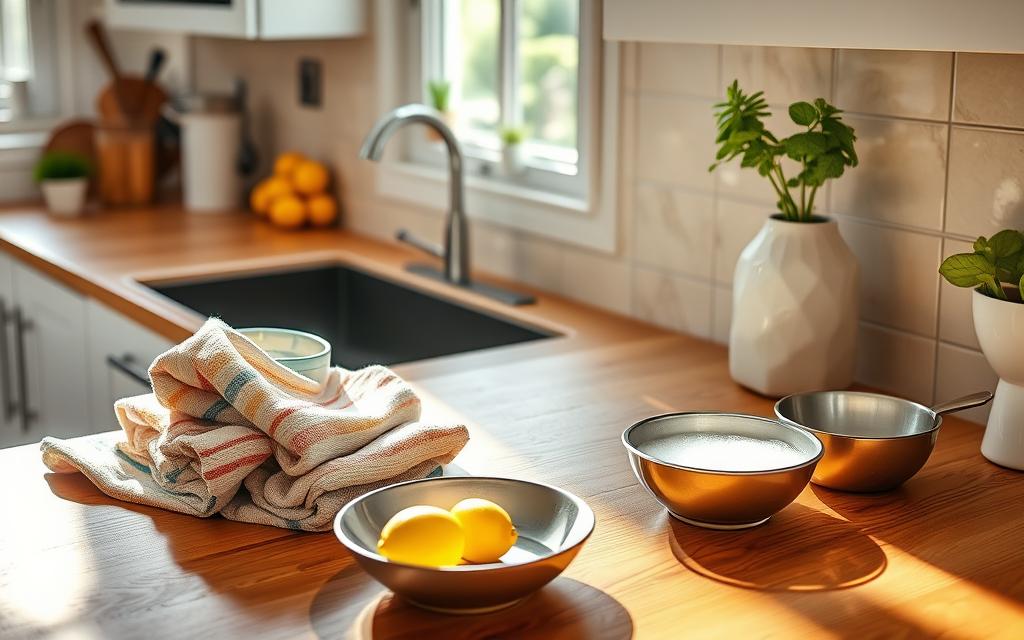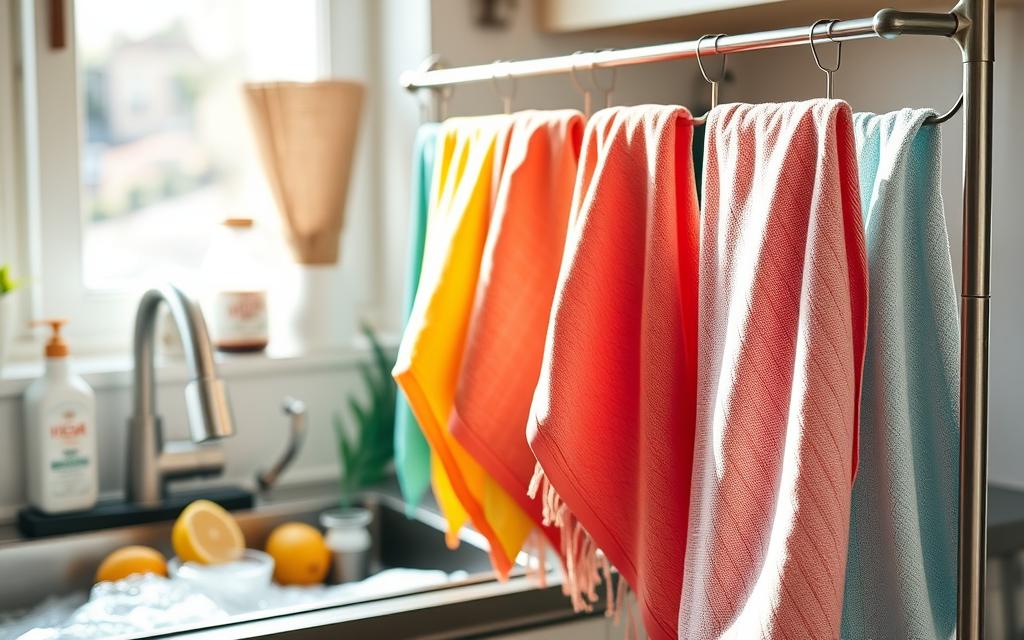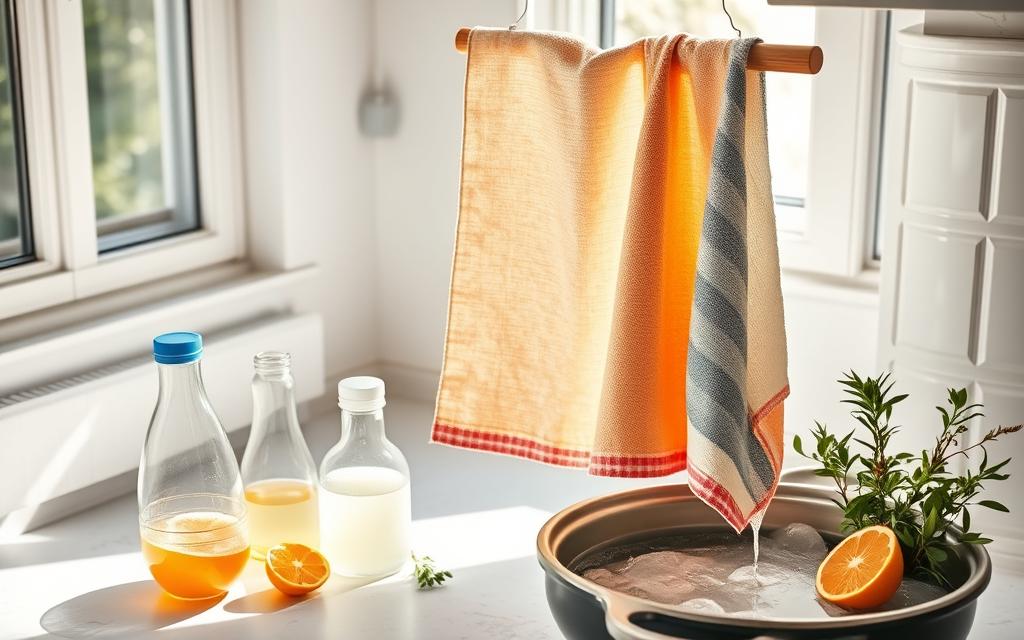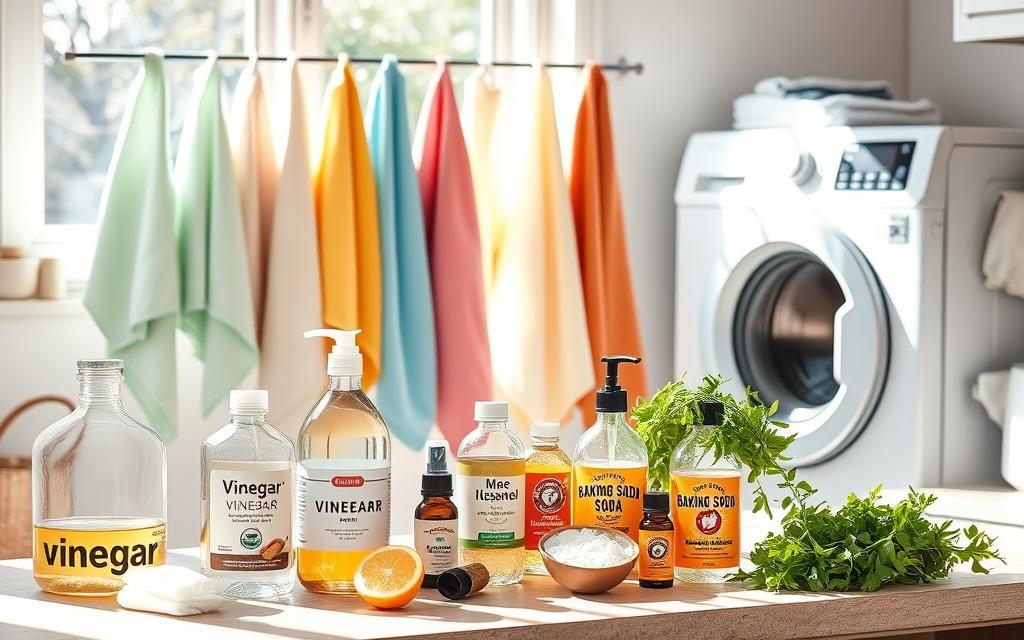Keeping your kitchen clean is essential for food safety, and dish towels play a significant role in this. While bleach might seem like an effective cleaning option, it can damage your towels and leave harmful residues. Instead, learn how to clean kitchen dish towels without bleach using safe and effective methods. These techniques will keep your towels fresh, germ-free, and in great condition without the risks associated with bleach.
Key Takeaways
- Dish towels can harbor up to 400 times more bacteria than a toilet seat if not properly cleaned.
- Washing with hot water and detergent can reduce bacteria on towels by up to 99.9%.
- Vinegar, baking soda, and other natural cleaning agents are effective alternatives to bleach.
- Proper storage and regular washing (every 2-3 days) are key to maintaining dish towel cleanliness.
- Knowing when to replace worn-out towels is important for kitchen hygiene.
Understanding the Need for Non-Bleach Cleaning Methods
Bleach can remove stains from dish towels, but it’s not always the best choice. Using bleach too much can weaken the fabric, shortening your towels’ life. Look for gentler cleaning methods to extend the lifespan of your dish towels and keep them fresh longer.
Why Avoid Bleach on Kitchen Towels?
Bleach is a strong chemical that can damage cotton fibers in your towels. It makes the fabric thin, brittle, and more likely to tear. Your towels may look worn and need to be replaced more often.
Risks of Using Bleach in the Kitchen
Bleach can also be risky in the kitchen. Its strong smell and fumes can be unpleasant and irritating. If bleach residue stays on towels or surfaces, it can contaminate food areas and pose health risks.
“For busy kitchens, it’s recommended to wash tea towels at least once a week to prevent bacteria buildup. Hot water at 60°C or higher is suggested to effectively kill harmful microorganisms.”
To remove stains from dish towels and keep them looking good, try gentler cleaning methods. Options like oxygen-based bleach, vinegar, baking soda, and lemon juice work well without harming the fabric.
Materials You’ll Need for Natural Cleaning
For eco-friendly towel cleaning and keeping dish towels fresh, harsh chemicals are not needed. You can find great cleaning solutions in your kitchen. Let’s look at common items you can use to remove tough stains and keep towels fresh.
Common Household Items for Cleaning
- White vinegar: An effective disinfectant and stain remover for various fabrics.
- Baking soda: A gentle abrasive that can lift stubborn grease and food stains.
- Lemon juice: The citric acid in lemon juice can break down and remove stains.
- Salt: A natural scrubbing agent for tackling tough messes.
Recommended Stain Removers
For oily stains, mix equal parts white vinegar and water as a pre-treatment. For grease marks, make a paste with baking soda and a few drops of dish soap. This combo can lift stubborn stains. You can also use a baking soda and water paste for tough spots.
Using these natural ingredients, you can clean and refresh your kitchen towels safely. This eco-friendly method keeps your towels in good condition and ensures a healthy kitchen.
Prepping Your Dish Towels for Cleaning
Before you start cleaning your kitchen dish towels, it’s key to prepare them right. This step makes your cleaning work better and gets your towels shining. Let’s look at how to get your towels ready for a deep clean.
Sorting Towels by Fabric Type
Begin by sorting your dish towels by their fabric. This helps you pick the best cleaning method for each towel. Put cotton, linen, and microfiber towels in separate piles for the right care.
Checking for Stains Before Cleaning
After sorting, check your towels for stains or dirty spots. Spotting these early lets you treat them with a stain remover before washing. This step helps remove tough stains and makes your towels look great.
To treat stains, apply a stain remover to the spot. Let it work for a few minutes before washing. This makes a big difference in how clean your towels will be.
Sorting and checking for stains are important steps. They help you clean your towels well and make them smell fresh. This preparation is key to having clean, fresh kitchen linens for a long time.
Hand Washing: A Gentle Approach
Hand washing your kitchen dish towels without bleach is a gentle and effective method. It lets you tackle stains and odors while keeping your towels in good shape. Here’s how to hand wash your towels with a simple baking soda solution.
How to Hand Wash with Baking Soda
- First, remove any visible debris or food from the towel. Rinse it under cool water to get rid of the initial grime.
- Fill a clean sink or basin with hot water. Add a couple of tablespoons of baking soda. This will help break down grease and odors without bleach’s harshness.
- Soak the towel in the baking soda solution for 15-20 minutes. Gently move it around in the water to work the solution into the fabric.
- Rinse the towel well under cool water to get rid of all baking soda. Make sure there’s no residue left, as it could make the towel smell or feel stiff.
- Wring out the towel gently to remove excess water. Be careful not to twist or wring it too hard, as this can harm the fibers.
Rinsing Techniques for Best Results
For delicate towels like microfiber or linen, use cooler water when rinsing. Hot water can cause them to shrink or break down over time. A cool water rinse will keep your towels soft and long-lasting.
By hand washing your towels with baking soda, you can clean them without harsh chemicals like bleach. This eco-friendly method keeps your towels looking good and smelling fresh.
Machine Washing: Safe Settings and Tips
Machine washing is a great way to clean your kitchen dish towels without bleach. It’s important to pick the right cycle and use eco-friendly detergents. This way, your towels will come out fresh and clean.
Selecting the Right Cycle for Dish Towels
For the best clean, choose a hot water cycle. Aim for water at 60°C (140°F) or higher. The heat makes the detergent work better and gets rid of bacteria and smells.
Also, using a biological detergent is a good idea. These detergents are made to tackle tough stains and give a deeper clean.
Using Eco-Friendly Detergents
- Choose plant-based or natural detergents without harsh chemicals like bleach or fabric softeners.
- Adding an antibacterial laundry additive can make your wash even more effective.
- For the ultimate clean, wash your towels at 90°C (194°F) as the UK government suggests.
Remember, don’t use fabric softeners. They can make your towels less absorbent. By following these tips, your dish towels will stay in top condition without harsh chemicals.
Natural Stain Removal Techniques
Keeping your kitchen dish towels clean doesn’t need harsh chemicals like bleach. There are many natural ways to remove removing stains from dish towels without harming the fabric. Let’s look at some effective home methods.
Lemon Juice and Vinegar Solutions
For tough stains, try hot water and OxiClean first. Lemon juice and white vinegar are great for natural dish towel fresheners. Soak the towel in lemon juice and water or vinegar and water before washing.
Baking Soda Paste for Tough Stains
For hard stains, make a baking soda paste. Mix the powder with water to get a thick paste. Rub it on the stain and wait 30 minutes before washing. Baking soda is tough on stains. For red wine or coffee, use an enzyme-based remover.
“Proper care can extend the lifespan of flour sack towels for years, making them more absorbent and soft with each use.”
Quick action and pre-treatment are key to natural stain removal. With the right ingredients, your towels will stay fresh and clean without harsh chemicals.
Drying Your Dish Towels Correctly
After cleaning your kitchen dish towels, it’s important to dry them right. This helps them last longer and stay effective. You can air dry or tumble dry, each with its own benefits and drawbacks.
Air Drying vs. Tumble Drying
There are a few ways to dry your dish towels. Air drying is gentle and keeps the towels fresh. Just hang or lay them flat in a breezy spot until they’re dry. For towels made of synthetic or blended materials, use a low heat setting in the dryer. But, avoid high heat to prevent them from shrinking or getting damaged.
Benefits of Sun Drying
Sun drying your towels has extra perks. The sun’s UV rays kill bacteria and odors naturally. It also makes your towels feel fresh and smell good. This helps your kitchen linens last longer.
| Drying Method | Benefits | Drawbacks |
|---|---|---|
| Air Drying |
|
|
| Tumble Drying |
|
|
Knowing the pros and cons of drying methods helps you care for your dish towels better. Whether you air dry or tumble dry, the right approach keeps your towels in great condition for a long time.
Best Practices for Maintaining Clean Towels
Keeping your kitchen towels clean is key to a hygienic cooking space. Simple steps can keep your towels fresh and ready for use. This way, your kitchen stays clean and safe.
Regular Cleaning Schedule
Make a routine for washing your dish towels. Wash them once a week, or more if they’re used a lot. Washing all towels together helps keep them clean.
Proper Storage Techniques
After washing, dry towels in a well-ventilated spot. Don’t bundle damp towels, as it can cause mildew and bad smells. Replace dirty towels weekly to keep your kitchen fresh.
| Recommendation | Frequency |
|---|---|
| Wash all kitchen towels in one load | 100% of the time |
| Wash all towels once a week | 100% of the time |
| Kids use more towels than adults | High occurrence rate |
| Use Glamorous Diva Wash for laundry | Highly recommended, 1/4 cup per load |
| Replace significantly soiled towels | At least once a week |
By sticking to these cleaning tips, your kitchen towels will stay clean and odor-free. This makes your kitchen a safe and healthy place for cooking and cleaning.
When to Replace Your Dish Towels
Even the cleanest dish towels can wear out over time. If they become thin, develop holes, or smell bad, it’s time for new ones. Signs like fraying, discoloration, and less absorbency mean they’ve reached the end.
Signs It’s Time for New Towels
Watch for signs your towels are no longer good. Look for thinning, stubborn stains, or a musty smell. If they’re shedding or not soaking up as well, it’s time for new ones.
Also, if you see holes or frayed edges, it’s time for a change. New towels can handle your kitchen’s demands better.
Choosing Sustainable Options for Replacement
When replacing your towels, go for eco-friendly ones. Opt for organic cotton or bamboo towels. They’re absorbent, durable, and good for the planet.
Choosing sustainable towels makes your kitchen cleaner and greener. It’s a step towards a better future.





Leave a Reply